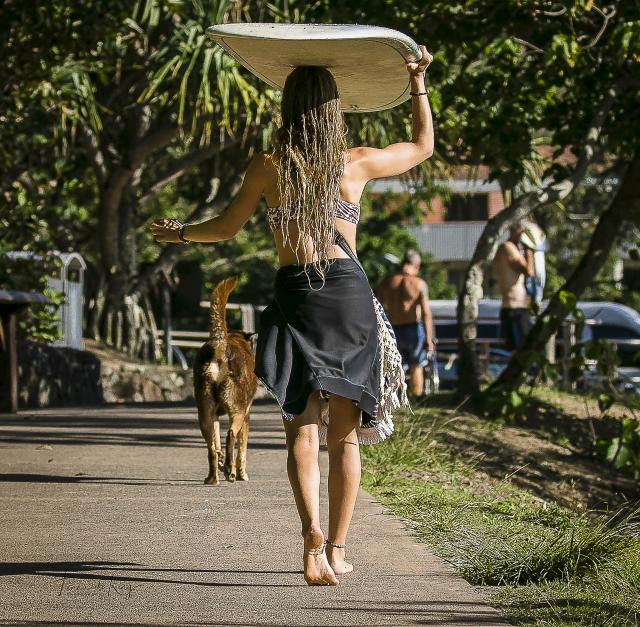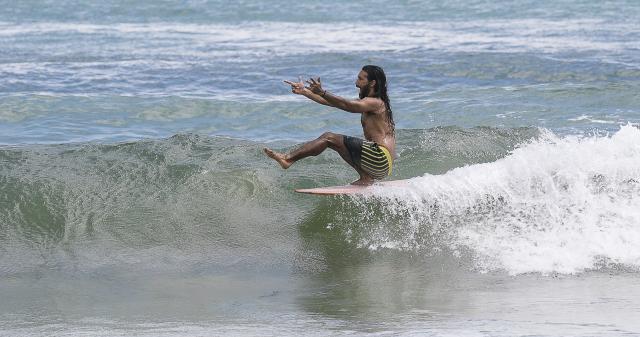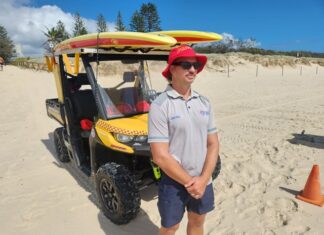Noosa is very unlikely to follow the lead of Byron Bay in introducing a leg rope (or surf leash) mandate with hefty fines for offenders in response to recent serious accidents involving loose boards in the surf.
Acting Noosa Council chief executive officer Larry Sengstock told Noosa Today: “Noosa Council has not considered going down the path that Byron Bay Council has undertaken, and there has been no official discussion on the issue that I am aware of. Of course, we expect there will be mixed views within the surfing fraternity.
“Currently our approach is that we support an education process through the erection of signage outlining the surf codes and rules, along with other safety measures, while working with the Noosa World Surfing Reserve stewardship council, Surf Life Saving Queensland and various other stakeholders.”
On 27 April Byron Shire became the first council in Australia to impose a leg rope law when it voted unanimously in favour of a motion put by Councillor Cate Coorey, citing “a long-held wish of residents, including the majority of the surfing fraternity, especially on our most crowded surf breaks”, and despite having received legal advice that such a law would be extremely difficult to police and enforce.
Ralph James, legal counsel for Byron Shire Council, said: “Council would need to show both that a surfer wasn’t wearing a leg rope in the water and that the accused reasonably passed near enough to a notice prior to entering the water that they could be said to have acted contrary to it. It is not clear how council enforcement officers could reasonably gather evidence of these elements.”
The new mandate carries an on the spot fine of $75 and up to $1100 if the matter goes to court.
As it does in Noosa and other densely-populated surfing destinations, the leg rope issue has reared its head in Byron often over the past decade, but two events in recent times have sent public outrage next level.
In 2019 local paper the Byron Echo published a full page advertisement for local legal firm Somersville Laundry Lomax posing the question, “Have you been injured by a surfer whose board was not restrained by a leg rope?” The firm claimed to have found precedents that would make civil damages cases easier to win, but apart from being accused of opportunism, SLL doesn’t seem to have won damages for any surf-related clients.
In February this year the leg rope issue hit the headlines again when Byron surfer Matt Cassidy had his bicep severed by an out of control surfboard at Wategos Beach. It was a serious injury and Cassidy was a highly competent surfer who was in control of his own board at the time, according to witnesses. What is less clear is whether the loose board that did the damage was unleashed by choice or whether the leg rope had snapped. But now the incident is written into history as the catalyst for the Byron leggie law.
In January 2022 there was similar confusion over whether a leg rope was in use when Noosa surfer Derek Symons required 17 staples in the back of his head after being run over by a surfboard at Noosa National Park. The 42-year-old was also a competent surfer who knew the break well, and since recovering he has been using his experience to help promote safer surfing practices. It was ironic that Derek’s serious injury came just weeks after the Noosa Council roundtable on surf safety, run in conjunction with the Noosa World Surfing Reserve, completed year-long deliberation on the best ways to mitigate increasing safety issues at our surf breaks due to over-crowding since Covid and higher numbers of novices taking to the water with no knowledge of basic safety and etiquette procedures.
The roundtable produced many great ideas, and council funding for parts of the NWSR’s safety and etiquette education and awareness program, but the problems remain. And one of them is that it’s all too easy to attack the low-hanging fruit every time there is a preventable surf injury – the leg rope averse traditional longboarders, sometimes derogatorily labelled “hipsters”. To understand the issue that Byron Bay has acted on, and so far we are not, despite suffering the same injury risks, you have to understand a little of the history.
From the start of the modern surfboard era in the mid-1950s, there were no leg ropes or leashes, and surfers who learnt their chops in the 1960s, as did this writer, knew that the first rule was control over your board, or face the long swim to the beach, or worse, to the rocks to pick up the pieces. Partly this was because when a French surfer named George Hennebutte invented a “footline” with elastic line and a double-velcro ankle strap in 1958, it rose without trace, presumably because no self-respecting surfer wanted to tie himself to his heavy board.
Even more than a decade later, there was no immediate uptake when Pat O’Neill, the son of wetsuit pioneer Jack O’Neill, invented a leash attached to the nose of his board by a suction cap in Santa Cruz, California in 1970, possibly because when Jack tried out the prototype it rebounded and took out his left eye. But every cloud has a silver lining, and Jack’s new pirate look graced all the advertising that made O’Neill Wetsuits one of surfing’s first super brands.
In the early ‘70s I surfed my way around the UK, Europe and half of Bali without using or seeing a leg rope, and it wasn’t until faced with surfing big waves at Uluwatu for the first time, an old hand persuaded me to borrow one of his leashes. I did and I was tied to my board for the next 20 years. But the longboard renaissance from the late 1980s brought with it a desire to get back to surfing’s traditions, and one of the most important was to walk up and down the board without hindrance. That has only become stronger.
I’ve watched the current WSL world champion longboarder, Noosa’s Harrison Roach surf since he was a little kid, and I’ve never seen him ride a longboard with a leg rope. Who am I to tell him times have changed, that because others can’t control their heavy boards, he must be tied to his? There has to be a better way to achieve behavioural change, because it is not just loose boards in the break that pose a clear and present danger. I asked both of Noosa’s surfing councillors for their views.
Cr Amelia Lorentson: “Surfing without a leg rope or with a leg rope can seriously injure others in the surf. The issue is surfer ability, not leg ropes. Understanding your limitations and knowing the rules – the Surf Code. This does not need mandating. What is required is education and strong community messaging. And it needs to be led by the surfing community and not regulatory bodies. Surfers listen to surfers.”
Cr Tom Wegener: “Noosa is blessed with some of the best waves in the world. Not the biggest or most challenging, but the best when all aspects are taken into account. As more people crowd into the surf, inevitably injuries occur from surfboards. What causes the injuries? Is it the knife-like fins on the board, the very hard rails, the pointy noses, or a loose board which was lost by someone without a leash? I think the danger begins when the rider is not in control of the board, with or without a leash. The true need is to instill the old fashion culture of maintaining control of your board at all times. It is recognising the situation on the day and surfing with others in mind, knowing your limits, and fitting in with the crowd.”
The Noosa World Surfing Reserve has not only been debating these issues for years, but also initiating appropriate educative responses. There is much to be seen on their website, noosaworldsurfingreserve.com.au, but the official response to Noosa Today’s request was:
“Noosa World Surfing Reserve opinion is that mandating anything is going to be difficult, so we strongly encourage leg-ropes for safety reasons. We live in a congested surf environment and the mitigation of the existing hazards, such as surfboards without leg-ropes, is essential to keep each other safe. Our education of locals and tourists should be seen in this light.”
Disclosure: The writer is a former president of the Noosa World Surfing Reserve and was co-chair of the Noosa Council Surf Safety Roundtable through 2021. He sometimes sneaks an unrestricted surf at a semi-deserted beach break, but for three years has worn a leg rope at all times on Noosa’s points, proving that an old dog can learn new tricks.











